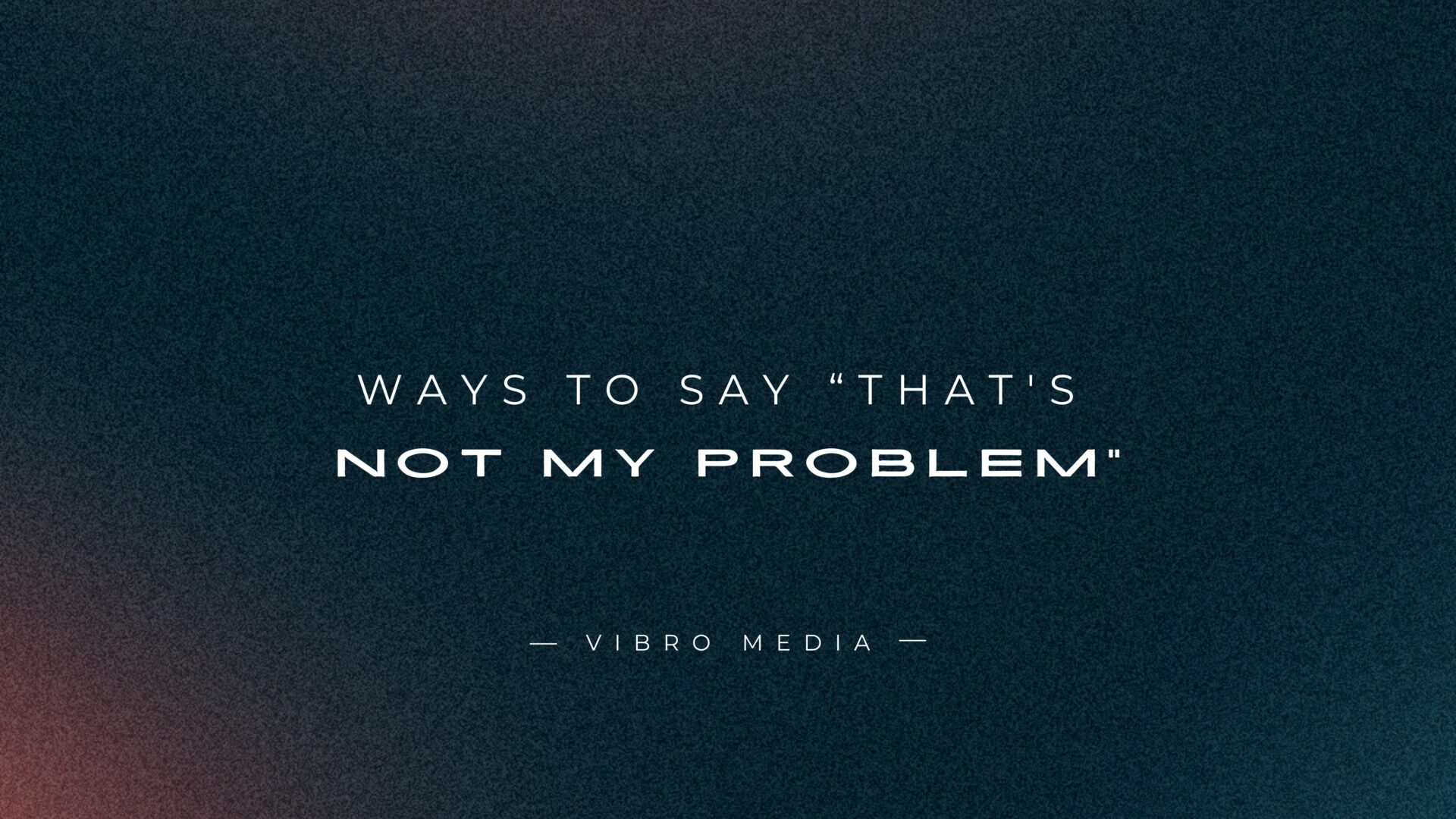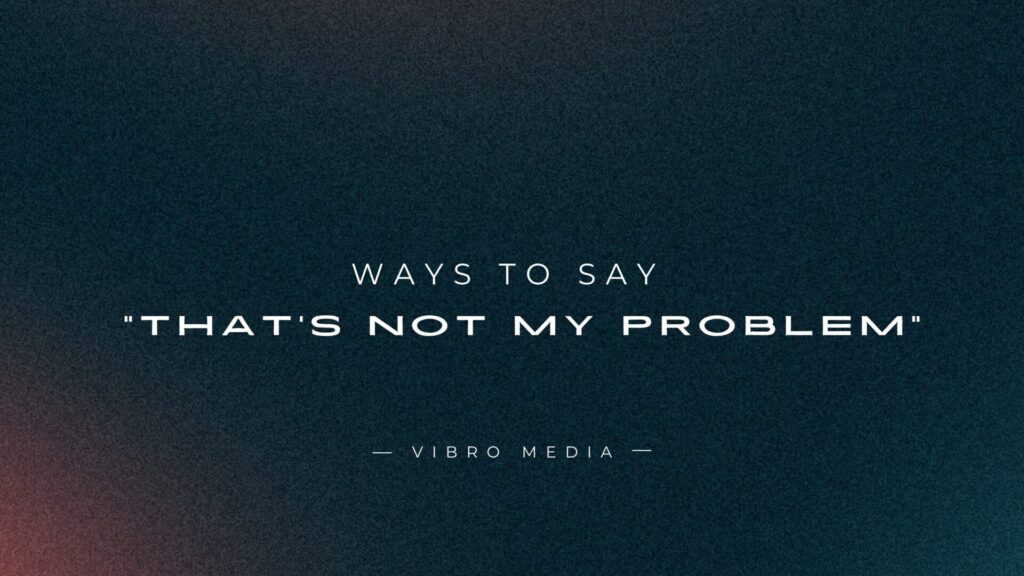200+ Ways To Say “That’s Not My Problem (It’s Yours)”

Setting boundaries is an essential yet often challenging aspect of communication. Whether in the workplace, among friends, or with family, knowing how to say “That’s Not My Problem” gracefully can save you from unnecessary stress and preserve your mental well-being. This phrase is often avoided due to the fear of conflict or the desire to please, which is crucial for maintaining healthy relationships and personal boundaries. In this article, we will explore various ways to convey the message without being rude, ensuring that you can keep your peace while being respectful to others.
The Importance of Setting Boundaries
Why do boundaries matter? Simply put, they define what is acceptable and what isn’t for yourself and others. Without clear boundaries, you risk overextending yourself, leading to burnout and resentment. Think of boundaries as invisible lines that protect your time, energy, and mental space. Just like a fence around your yard, they help you keep the things you want in and the things you don’t out.
Setting boundaries is not just about saying “no”; it’s about creating a framework for interacting with others and managing your needs. Establishing and communicating these boundaries clearly creates a healthier environment for yourself and those around you.
Why People Avoid Saying “That’s Not My Problem”
Many people shy away from saying, “That’s Not My Problem,” because they fear conflict. No one wants to be seen as uncooperative or cold. The desire to be liked and the pressure to be helpful can make it difficult to refuse someone’s request, even when it’s not your responsibility. But remember, saying yes to everything can leave you feeling drained and unappreciated.
Avoiding conflict and seeking approval are natural human tendencies. However, constantly putting others’ needs before your own can lead to exhaustion and resentment. Asserting your boundaries is essential for maintaining a balanced and fulfilling life.
The Art of Saying No Gracefully
Saying no is an art form. It requires tact, empathy, and, most importantly, confidence. A polite decline can be more effective than a blunt refusal. For instance, instead of saying, “I don’t want to do this,” you could say, “I’m currently focused on other priorities.” This way, you’re not dismissing the person’s request outright but indicating that you have other commitments.
To say no gracefully, you can also:
- Express appreciation: Start by acknowledging the request. “Thank you for thinking of me, but…”
- Be honest but kind: Clearly state your position without sounding harsh. “I’m really swamped with other tasks right now.”
- Offer alternatives: Suggest other ways the person might find help. “Perhaps you could ask [Name] for assistance.”

200+ Ways To Say “That’s Not My Problem (It’s Yours)”
Direct and Blunt
- That’s your issue to resolve.
- Not my problem, it’s yours.
- You’ll have to figure that out.
- I’m not responsible for that.
- That’s not my concern.
- Handle it yourself.
- That’s not up to me.
- You’re on your own with this.
- That’s not my area to deal with.
- That’s all on you.
Polite and Diplomatic
- This falls within your area of responsibility.
- You should take the lead on this.
- You’ll be able to handle this.
- This is something you should address.
- I’m not able to deal with this, but you can.
- It might be best if you take care of this.
- This matter is under your purview.
- You’re the best person to manage this.
- This issue is more relevant to your role.
- This is something for you to work out.
Humorous or Light-hearted
- Not my rodeo, not my bull.
- Looks like you’re the star of this show!
- That’s a you thing, not a me thing.
- I’m just here for the snacks, not the drama.
- That’s your puzzle to solve, not mine.
- I’m just a spectator in this game.
- That sounds like a ‘you’ adventure.
- I’m just here to watch the fireworks.
- This is your quest, hero!
- Looks like you’ve got a little situation there!
Professional and Formal
- This matter falls outside my area of responsibility.
- You should consult with the appropriate department for this issue.
- I recommend addressing this with the relevant team.
- This task aligns differently with my current role.
- I’m not authorised to handle this; please contact the designated personnel.
- This issue does not pertain to my duties.
- It would be best to escalate this to the appropriate channels.
- Please refer to the policy or department responsible for this.
- I’m unable to assist as this is outside my scope.
- This is outside my jurisdiction and should be handled by the relevant party.
Colloquial and Casual
- That’s your gig, not mine.
- You’ve got a deal with that yourself.
- Not my thing to worry about.
- That’s all you, buddy.
- I’m not getting into that mess.
- You’ve got to handle that one.
- That’s your ball to juggle.
- You’re on your own with that.
- That’s not in my wheelhouse.
- You’re the one in charge of that.
Empathetic yet Firm
- I understand your situation, but it’s something you need to address.
- I sympathise with what you’re going through, but it’s your responsibility.
- I see it’s challenging, but managing it is up to you.
- I know it’s tough, but you need to handle this.
- I wish I could help more, but this falls on you.
- I can see how difficult this is, but it’s your call to make.
- I understand your origin, but I need help to step in on this.
- I feel for you, but you need to figure out this.
- I understand it’s difficult, but this is your issue.
- I know it’s a tough spot, but you must take charge here.
Sarcastic
- Oh, I’m sure you’ve got this under control.
- Wow, it sounds like a great opportunity for you!
- Let me know how that works out for you.
- Good luck with that!
- Yeah, it’s not my concern, but thanks for sharing.
- I’d love to help, but I don’t want to.
- Wow, that sounds like a ‘you’ problem.
- Sounds like a real toughie. Glad I’m not involved!
- I’m dying to take that off your hands—not.
- Oh, I’d jump right in, but… no.
Encouraging
- I believe in you! You can handle this.
- You’ve got the skills to manage this.
- You’re more than capable of sorting this out.
- You can tackle this challenge.
- You’ve handled tougher situations before.
- This is a great opportunity for you to shine.
- You’re the right person for this task.
- You’ve got the experience to deal with this.
- I trust your judgment on this.
- You can figure this out.
Delegating
- I’m assigning this task to you.
- This is your project to lead.
- Please take the lead on this.
- I’m counting on you to manage this.
- This responsibility is yours to oversee.
- Please handle this situation accordingly.
- I need you to take charge of this matter.
- This falls under your area, so I’ll let you handle it.
- I’m delegating this to you as it’s within your expertise.
- You’re responsible for seeing this through.
Noncommittal
- I’m not involved in that situation.
- That’s not something I need to worry about.
- I’m staying out of this one.
- That’s missing from my list of priorities.
- I’m not connected to that issue.
- That’s outside my area of focus.
- I’m not taking a position on that.
- That’s not something I’m dealing with.
- I’m not part of that discussion.
- That’s not something I’ve been involved in.
Instructive
- You need to take responsibility for this.
- You need to handle this situation.
- You should figure out how to resolve this.
- This is something you need to address.
- You have to find a solution to this.
- It’s up to you to sort this out.
- Make sure you take care of this.
- You need to manage this on your own.
- It’s your job to fix this issue.
- You have to step up and handle this.
Relational
- This is something you need to take care of.
- It’s up to you to manage this situation.
- You’re the one who needs to address this.
- This responsibility falls on you.
- You’re in charge of handling this.
- This is in your court.
- You must take care of this.
- This is a matter for you to resolve.
- You’re the one who needs to deal with this.
- It’s your call to proceed with this.
Philosophical or Reflective
- Everyone has their battles to fight.
- This is part of your journey, not mine.
- We all have our responsibilities to manage.
- Sometimes, we must face challenges on our own.
- Each person has a path to walk.
- This is a lesson meant for you.
- It’s a part of your growth process.
- We all have different roles to play in life.
- This is your cross to bear.
- In life, we all have our burdens to carry.
Passive-Aggressive
- I’m sure you’ll find a way to handle it.
- I’m sure you’ll be just fine.
- Good luck with whatever that is.
- Oh, I didn’t realise that was still an issue.
- You have everything under control, right?
- You always seem to manage somehow.
- I’m sure you’ll figure it out eventually.
- That sounds like something you need to take care of.
- Wow, it must be nice to have so much going on.
- I can’t wait to see how you handle this.
Legal or Contractual
- This isn’t covered under my contract.
- That’s not within my legal responsibilities.
- This issue falls outside the scope of our agreement.
- This matter is not included in my terms of service.
- This isn’t specified in my contractual duties.
- My involvement is limited to what’s outlined in our contract.
- This responsibility is not legally assigned to me.
- This situation is beyond my contractual obligations.
- I’m not liable for handling this.
- This falls outside the parameters of my role.
Aloof or Detached
- That’s something other than what I get involved in.
- I’m not connected to that issue.
- That’s not on my radar.
- I’m not interested in that matter.
- That’s not something I’m concerned with.
- I’m not focused on that right now.
- That’s outside my sphere of influence.
- I’m not attached to that situation.
- I’m indifferent to that issue.
- That doesn’t affect me.
Metaphorical
- The ball’s in your court.
- That’s your boat to row.
- You have to dance with the one who brought you.
- You’ve got the wheel; drive this one.
- It’s your mountain to climb.
- That’s your dragon to slay.
- You’ve got to weather this storm.
- The baton is in your hand.
- That’s your puzzle to piece together.
- You’re holding the reins on this one.
Deflective
- Let’s focus on your role in this.
- I should address something else.
- This isn’t about me.
- You should take this up with someone else.
- I’m not the right person for this.
- That’s different from my area of expertise.
- You should talk to someone else about this.
- That’s outside my current priorities.
- This doesn’t involve me directly.
- I’m not the one to handle that.
Instructional
- You need to take the initiative on this.
- You must handle this situation.
- This is something you should address yourself.
- You should find a solution to this.
- It’s your responsibility to manage this.
- You should look into this matter.
- You have to take charge and resolve this.
- You must deal with this issue.
- You need to step up and handle this.
- Make sure you follow up on this.
Playful or Teasing
- Looks like you’ve got your hands full!
- Tag, you’re it!
- Guess who’s the lucky one?
- Oh, this one’s all you!
- You’re the star of this show!
- Sounds like you’ve got an adventure ahead!
- It’s time for you to be the hero.
- Time to put on your big-kid pants!
- This sounds like a job for you, superhero!
- Well, this should be fun for you!
When to Use Direct vs. Indirect Approaches
The choice between direct and indirect approaches depends on the situation and your relationship with the person. In professional settings, direct approaches are often more effective and clear. They help to avoid misunderstandings and set firm boundaries. For example, saying “I’m not the right person for this” in a work environment clearly defines your responsibilities.
An indirect approach may be more appropriate in personal relationships to maintain harmony. For instance, suggesting that the person might be more equipped for the task can preserve the relationship while still communicating your boundaries. Choosing the right approach involves considering the context and your goals for the interaction.
How to Maintain Professionalism and Respect
It’s crucial to be respectful and professional, even when setting boundaries. Words can be powerful, and choosing them carefully can make a significant difference. Phrases like “I appreciate your understanding” or “Thank you for considering my situation” can soften the impact of a refusal.
Maintaining professionalism involves:
- Being clear but courteous: Communicate your boundaries clearly without sounding abrasive.
- Acknowledging the request: Show that you value the person’s needs even if you can’t fulfil them.
- Offering support in other ways: Provide alternatives or suggest other resources.
The Role of Tone and Body Language
Tone and body language significantly affect how your message is received. A calm and steady tone conveys confidence, while a friendly smile can show that you mean no harm. Avoid crossing your arms or looking away; these can be interpreted as defensive or dismissive.
To ensure your message is received positively:
- Maintain a neutral tone: Avoid sounding sarcastic or irritated.
- Open body language: Face the person directly and use gestures that convey openness.
- Be mindful of your facial expressions: Ensure your expressions match the intended message.
The Benefits of Saying “That’s Not My Problem”
Setting boundaries has several benefits. First, it allows you to focus on your priorities, ensuring that your time and energy are spent on what truly matters. Second, by declining additional tasks, you can concentrate on your core responsibilities and avoid being overwhelmed.
Secondly, it encourages others to take responsibility for their issues, fostering a sense of accountability. When people realise they need to handle their problems, it can lead to greater self-sufficiency and growth.
Lastly, it protects your mental health by preventing burnout and reducing stress. You maintain a healthier balance between work and personal life by managing your commitments effectively.
Potential Consequences and How to Handle Them
Saying, “That’s Not My Problem,” can sometimes lead to misunderstandings or hurt feelings. To minimise these risks, it’s essential to communicate clearly and empathetically. If backlash occurs, stay calm and reiterate your reasons for setting the boundary.
To handle potential consequences:
- Listen to concerns: If someone is upset, hear them out and validate their feelings.
- Reiterate your position politely: Restate your boundaries without being defensive.
- Seek resolution if needed: Offer to discuss alternatives or solutions that might work for both parties.
Real-Life Scenarios and Examples
- Workplace Situations
In the workplace, you might encounter colleagues who try to offload their responsibilities onto you. For example, if a coworker asks you to cover for them frequently, you could say, “I’m working on a tight deadline myself. Maybe you could ask someone else?” This response is firm yet considerate, acknowledging their request while redirecting it.
- Personal Relationships
Setting boundaries can be even more challenging in personal relationships. If a family member tries to involve you in a drama you’re not interested in, you could say, “I care about you, but I can’t get involved in this situation. It’s best if you handle it directly.” This approach shows empathy while maintaining your boundaries.
The Importance of Self-Care and Personal Boundaries
Setting boundaries is a form of self-care. It helps you prioritise your mental and emotional well-being, allowing you to recharge and avoid burnout. By clearly defining what you can and cannot do, you protect yourself from being overwhelmed and maintain a healthy balance in your life.
Self-care includes:
- Prioritising rest: Ensure you have time for relaxation and recovery.
- Managing stress: Use techniques like mindfulness or exercise to handle stress.
- Seeking support: Contact friends, family, or professionals if you need help.
Tips for Practicing and Improving Boundary Setting
- Start small and build confidence: Begin with minor requests and gradually work up to more significant issues. This helps you gain confidence in setting boundaries.
- Practice with trusted friends: Role-playing scenarios can help you feel more comfortable setting real-life boundaries.
- Reflect on your experiences: After setting a boundary, take some time to reflect on how it went and what you could improve. This reflection can help refine your approach and become more effective at boundary setting.
Conclusion
In conclusion, having a repertoire of ways to say, “That’s not my problem (it’s yours)”, can be incredibly valuable in navigating various situations where boundaries need to be established. Whether you need to address a challenging colleague or a persistent friend or simply want to assert your own space, these 200+ phrases give you the tools to communicate effectively and confidently. If you’re also looking for ways to handle those nosy individuals who can’t seem to respect your privacy, be sure to
check out our guide on:
How to Shut Down “Nosy People”: 200+ Best Comebacks
FAQs
Q. How do I say “That’s not my problem” without feeling guilty?
Start by focusing on your own needs and responsibilities. Remember, it’s okay to prioritise your well-being.
Q. What if the person gets upset when I say, “That’s not my problem”?
Stay calm and explain your reasoning. Reiterate your boundaries and offer support in other ways.
Q. Can I say “That’s not my problem” to my boss?
Yes, but be tactful. Frame it in terms of your current workload and responsibilities rather than outright refusal.
Q. Is it selfish to set boundaries?
No, setting boundaries is a healthy practice that helps you manage your time and energy effectively.
Q. How can I set boundaries without feeling rude?
Use polite language and show empathy. Phrases like “I wish I could help, but I’m currently focused on other tasks” can soften the impact.






